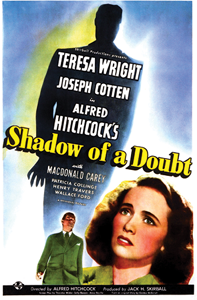
1943

EVERETT
Shadow of a Doubt
DIR. ALFRED HITCHCOCK

© UNIVERSAL PICTURES, COURTESY PHOTOFEST
Uncle Charlie, the Merry Widow Murderer (played by Joseph Cotten), menaces his niece (Teresa Wright) in Shadow of a Doubt.
Reportedly inspired by a real-life serial killer who took refuge with his extended family in a small California town, Hitchcock’s Shadow of a Doubt focuses on the relationship between a young woman nicknamed Charlie (Teresa Wright) and her namesake, the beloved Uncle Charlie (Joseph Cotten). The two are so close, they’re almost psychically linked—until Charlie begins to suspect that her uncle is the so-called Merry Widow Murderer, and that he has come to stay with her family in Santa Rosa, California, to escape capture back east.
Her growing unease is hardly surprising, given that the genial uncle eventually drops his defenses, revealing a glimpse of the sick monster behind the slick façade. “Do you know the world is a foul sty?” he says to her. “Do you know if you ripped the fronts off houses, you’d find swine?” In this, he echoes the sentiments of serial killers everywhere—both on- and offscreen. (“What sick ridiculous puppets we are,” Kevin Spacey’s killer says in 1995’s Seven. “And what gross little stage we dance on.”)
Co-written by playwright Thornton Wilder (Our Town) and Sally Benson (Meet Me in St. Louis)—two eminent chroniclers of small-town Americana—the film was among Hitchcock’s favorites, in part because he loved working with Wilder. “In England I’d always had the collaboration of top stars and the finest writers,” the master told the French filmmaker François Truffaut, “but in America things were quite different. I was turned down by many stars and by writers who looked down their noses at the genre I work in. That’s why it was so gratifying for me to find out that one of America’s most eminent playwrights was willing to work with me and, indeed, that he took the whole thing quite seriously.”
In the process, the two created something of an anomaly. Though Hitchcock loved stories about wrongly accused men—think Cary Grant in North by Northwest or Henry Fonda in, well, The Wrong Man—Uncle Charlie’s guilt is rarely in question, though it’s belied by Cotten’s genial blandness. The film is atypical as far as noir goes, too. Much of the genre takes place in urban darkness, but Shadow of a Doubt (despite its title) is awash in wholesome sunlight. But the contrast between the superficially serene surroundings and the dark underbelly represented by Uncle Charlie is what gives the film its subversive heft. (Think a portrait of Norman Bates by Norman Rockwell.)
“This is Hitchcock’s most wicked vision of America,” noir expert and novelist Jake Hinkson tells LIFE. “Go beyond the manicured lawns and the loving family façade, Hitch seems to be telling us, and you’ll find neurosis and sociopathy and murder. This is basically Blue Velvet 40 years early.” Blue Velvet’s director, David Lynch, even paid homage to the surreally dancing figures shown in the Hitchcock film’s beginning in the opening of 2001’s Mulholland Drive.
Though Hitchcock isn’t generally associated with noir, he had worked in Berlin early in his career and was deeply influenced by German expressionism, which helped define the genre’s look. He also admired Raymond Chandler, the pulp writer who exerted such an influence on Billy Wilder’s Double Indemnity, which was released a year after Shadow of a Doubt.
Indeed, Hitch ended up hiring the novelist to co-write his 1951 film, Strangers on a Train. Unfortunately, he had even less success with the notoriously difficult man than Billy Wilder did. Never one to hide behind a slick façade, Chandler wrote Hitchcock a scathing letter. “What I cannot understand is your permitting a script which after all had some life and vitality to be reduced to such a flabby mass of clichés, a group of faceless characters,” he ranted. “If you wanted something written in skim milk, why on earth did you bother to come to me in the first place?” As to the director himself? Chandler called the Master of Suspense “that fat bastard.”

J. R. EYERMAN/LIFE/THE PICTURE COLLECTION
Director Alfred Hitchcock weighs in (above) and gives pointers to his cast on the Santa Rosa, California, set of Shadow of a Doubt (below), shown here in LIFE’s exclusive behind-the-scenes story on the making of the film. Though Hitch was used to spending upwards of $100,000 on sets, wartime restrictions dictated that no more than $5,000 could be spent on new materials, forcing the director to shoot on location in New Jersey and Santa Rosa. The cast and crew took over the entire city for four weeks, LIFE wrote, “converting it into a complete motion-picture studio.”

EVERETT

GJON MILI/LIFE/THE PICTURE COLLECTION
In a series of stroboscopic images created exclusively for LIFE, Alfred Hitchcock shows Shadow of a Doubt leading lady Teresa Wright the finer points of being menaced by a serial killer.